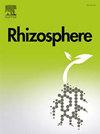Multilevel analysis of Azospirillum biofilms and cystlike forms and characterization of their possible role in wheat drought tolerance
IF 3.4
3区 生物学
Q1 PLANT SCIENCES
引用次数: 0
Abstract
The type strains Azospirillum brasilense Sp7 and A. baldaniorum Sp245, capable of penetrating plant roots, formed mono- and multilayered biofilms on the wheat root surface both in sterile aqueous medium and in nonsterile soil. The biofilms formed on an abiotic surface under hydroponic conditions also were mono- and multilayered. In the wheat root system, the azospirilla produced biofilms mainly on the root apex, the root hairs, and the areas of lateral root development, regardless of the growth conditions. It was exactly in these root zones that a lectin identical to wheat germ agglutinin had previously been detected, and a hapten specific for this lectin was present in the biofilm matrix of the strains under study. The synthesis of osmoprotectants and glycopolymers and the formation of cystlike forms by Azospirillum contributed to biofilm survival during drying. The biofilm components played a part in increasing the resistance of the Azospirillum-inoculated plants to drought-simulating conditions in soil. The same components played a role in increasing the resistance of Azospirillum-inoculated plants to simulated soil drought. Drought was simulated by stopping soil watering for 10 days. The Sp7-derived phenotypic variant Sp7.8, which develops large cystlike forms with a complex morphology, not only remained viable during biofilm desiccation but also protected the plants from the negative effects of soil drought more successfully than did the parent strain. In biofilms, the phenotypic variant Sp7.8 formed 1.8 times more cystlike forms (under N-sufficient conditions) than did strain Sp7.
求助全文
约1分钟内获得全文
求助全文
来源期刊

Rhizosphere
Agricultural and Biological Sciences-Agronomy and Crop Science
CiteScore
5.70
自引率
8.10%
发文量
155
审稿时长
29 days
期刊介绍:
Rhizosphere aims to advance the frontier of our understanding of plant-soil interactions. Rhizosphere is a multidisciplinary journal that publishes research on the interactions between plant roots, soil organisms, nutrients, and water. Except carbon fixation by photosynthesis, plants obtain all other elements primarily from soil through roots.
We are beginning to understand how communications at the rhizosphere, with soil organisms and other plant species, affect root exudates and nutrient uptake. This rapidly evolving subject utilizes molecular biology and genomic tools, food web or community structure manipulations, high performance liquid chromatography, isotopic analysis, diverse spectroscopic analytics, tomography and other microscopy, complex statistical and modeling tools.
 求助内容:
求助内容: 应助结果提醒方式:
应助结果提醒方式:


